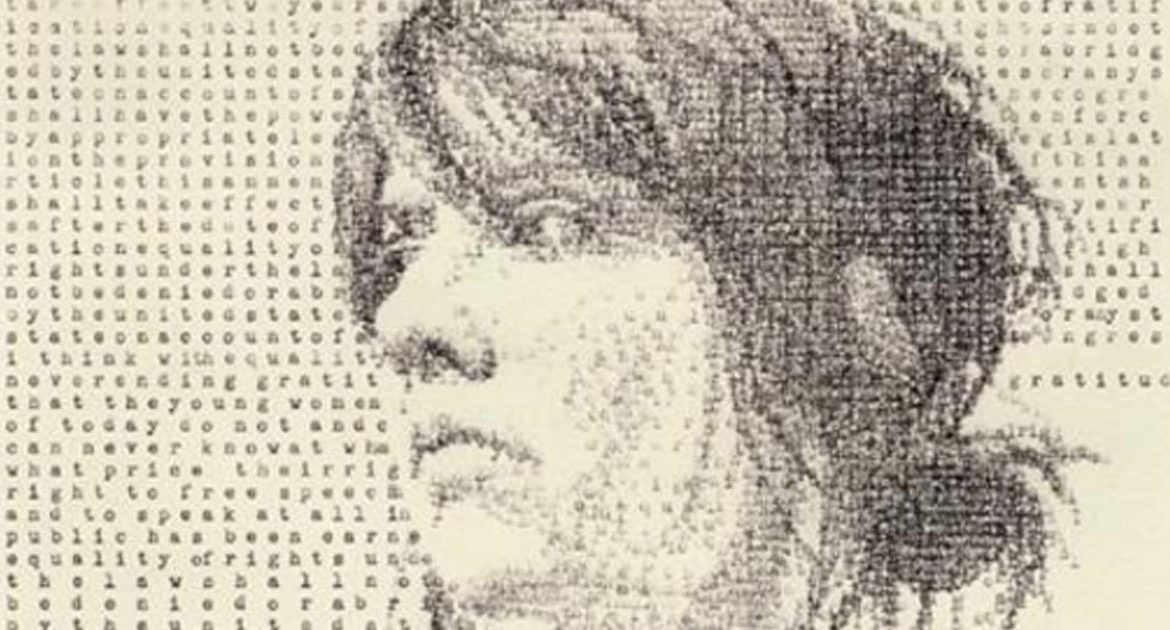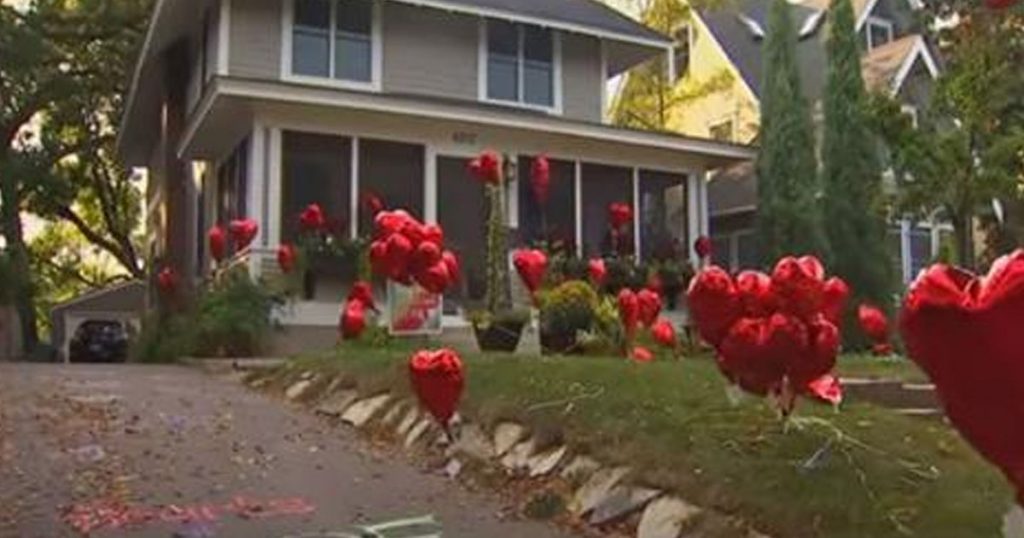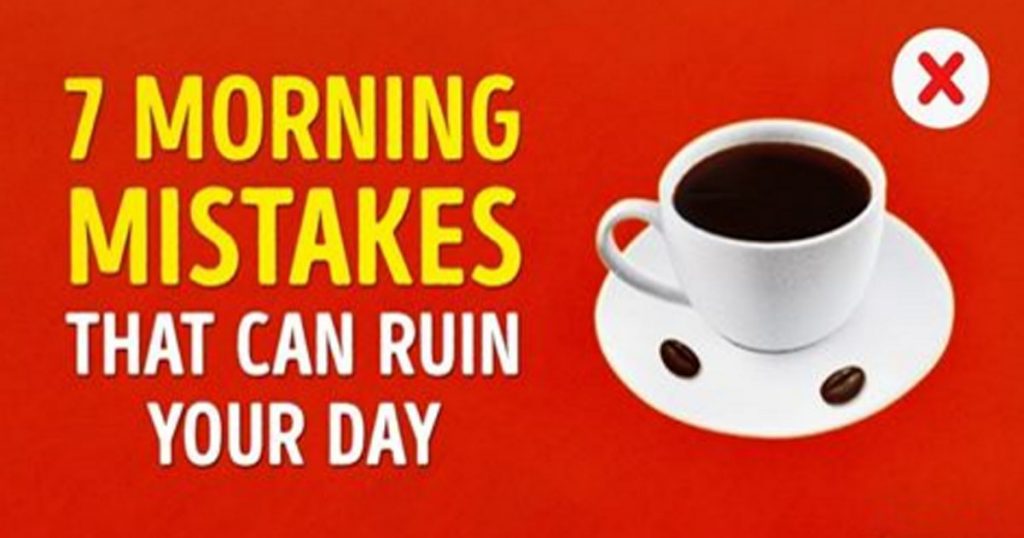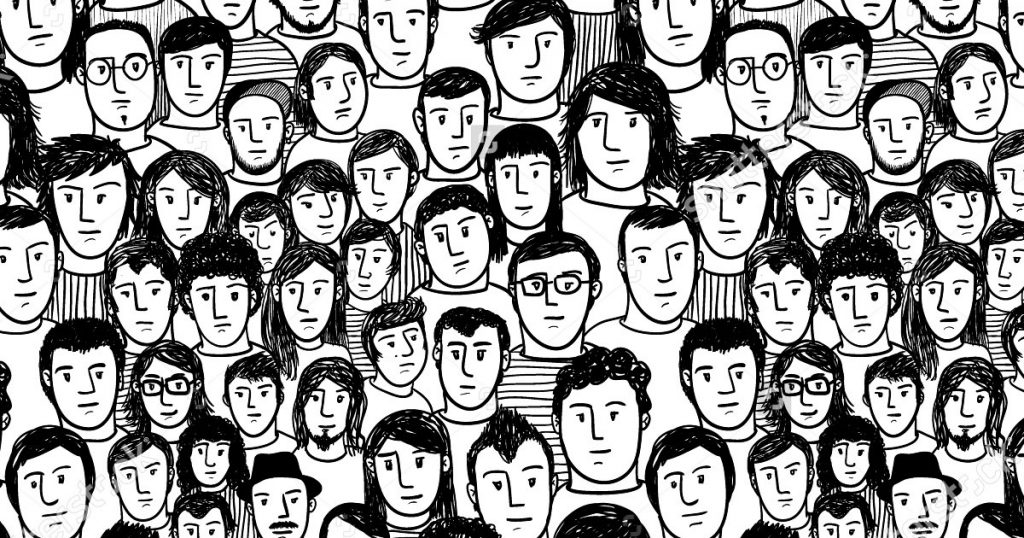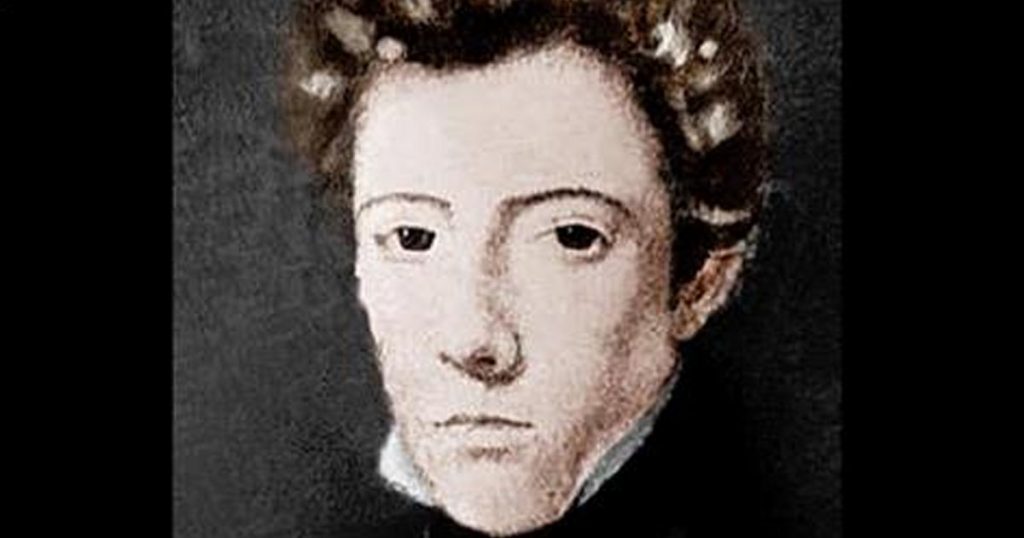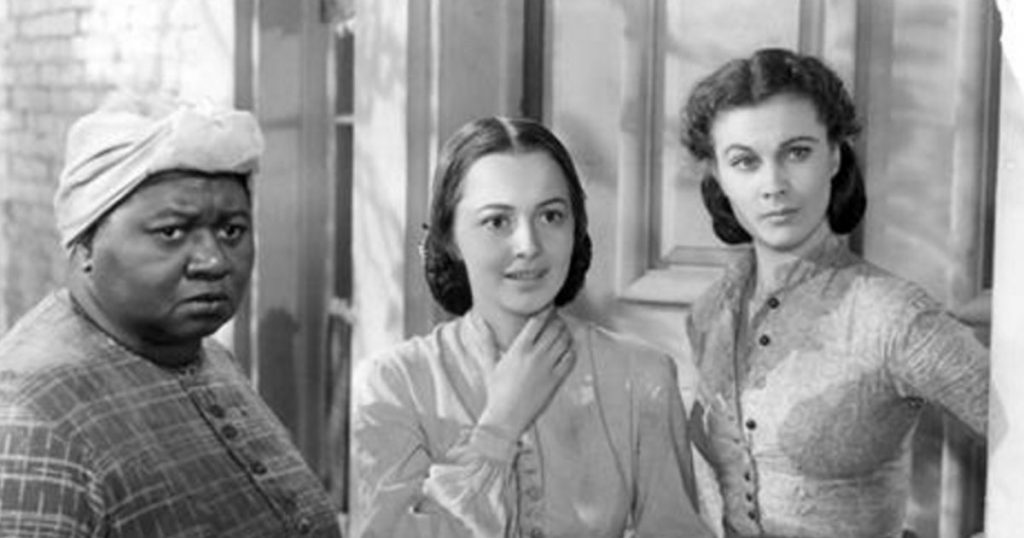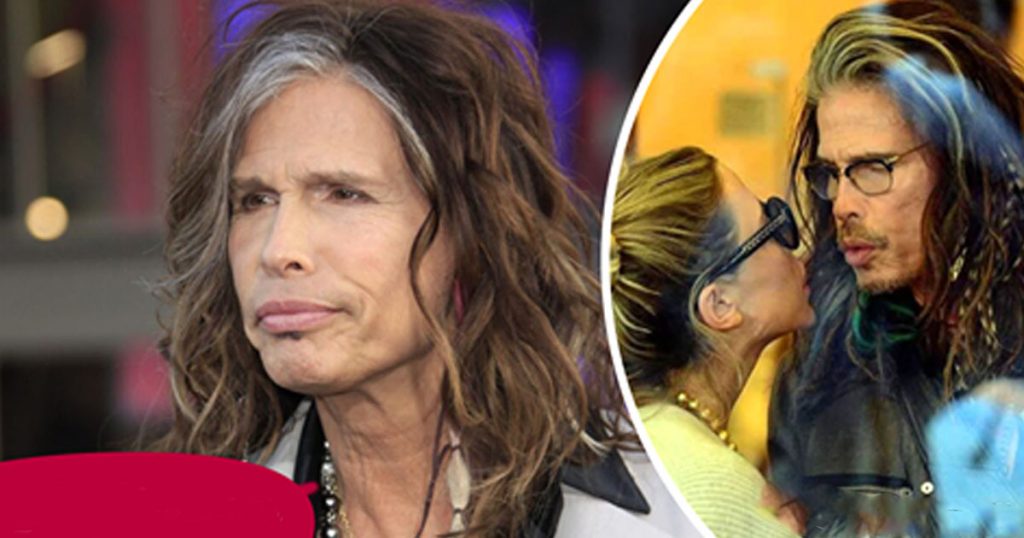“Art is not a thing — it is a way,” Elbert Hubbard observed in 1908 in what became one of history’s finest definitions of art. Hubbard was writing at the dawn of an unusual new art form, wherein artists were appropriating a new thing — a trailblazing technology — to find a new way of making art. The product and legacy of that is what graphic design scholar Barrie Tullett explores in Typewriter Art: A Modern Anthology (public library) — a fascinating chronicle of “the development of the typewriter as a medium for creating work far beyond anything envisioned by the machine’s makers,” embedded in which is a beautiful allegory for how all technology is eventually co-opted as an unforeseen canvas for art and political statement.
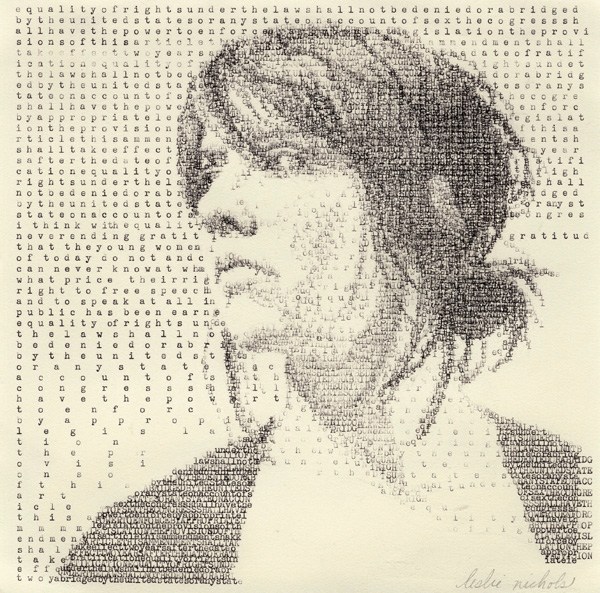
‘Looking Forward’ by Leslie Nichols (2010)
Trained as a traditional painter, Nichols now combines texts with images to create mixed-media landscapes and portraits. Her typewriter text portraits are driven by a desire to understand different facets of women’s rights and identity as well as her place, and sense of womanhood, in her own community. Nichols creates large-scale text pieces with hand-stamped oil-based inks and stenciled graphite; smaller, more intimate pieces are produced entirely with a manual typewriter.
What makes this unusual art form so enchanting is that it blends the compositional drama of drawing with the patterned precision of the machine. But what is typewriter art anyway? The definition, Tullett argues, is both very broad and very personal:
For some artists, it is an object to draw — from the machine itself, to the ephemera associated with it (typewriter oils, ribbon cases and so on) — or an object to make art from, whether that be the music of the Boston Typewriter Orchestra, or sculptural pieces and explorations… For others, however, the typewriter is a tool to draw with; a means of making art.
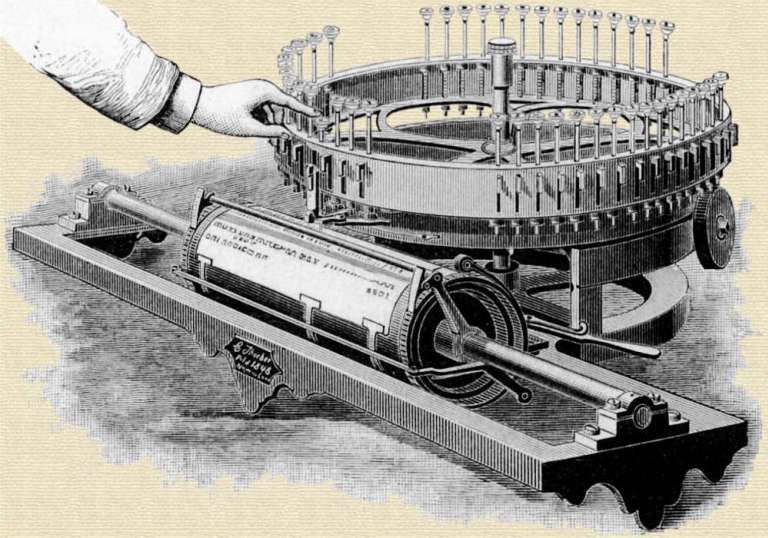
Charles Thurber’s typewriter patent, 1843
The first practical typewriter was invented by Charles Thurber and patented in 1843, but was it never manufactured. The first true typewriter to be manufactured, the Hansen Writing Ball, made its public debut in 1870, but it was another four years until a commercially successful machine took off. Much like the bicycle, one of the most immediate and palpable roles of the new technology was in the emancipation of women — not only did the typewriter create a whole new sphere of female employment, but it also provided a medium of democratic political communication outside the patriarchal regime’s circle of censorship. It was, as Tullett notes, a revolution.
As is the case in any cultural revolution, artists were quick to appropriate its medium for their own message.
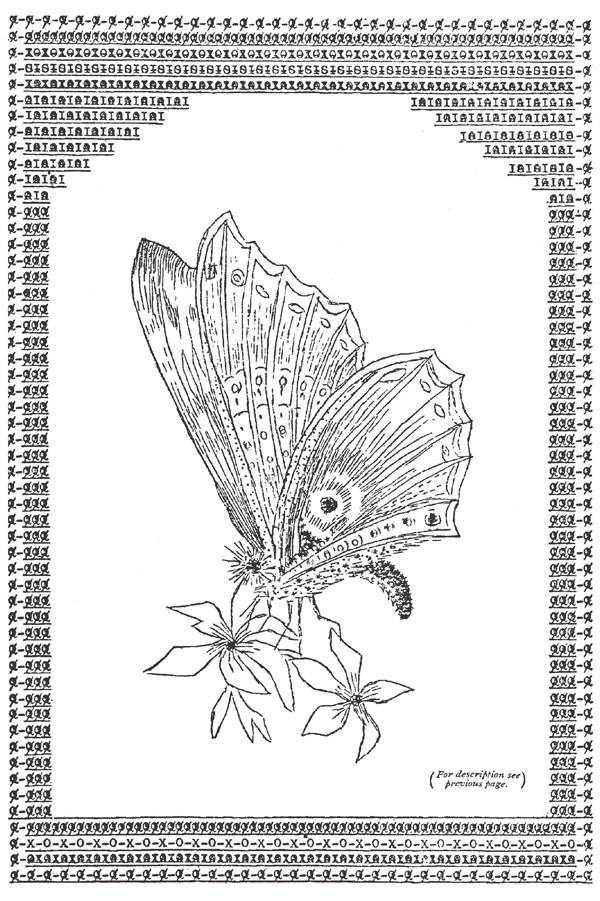
Untitled by Flora F.F. Stacey (1898)
For nearly a century, it was believed that the very first known example of typewriter art appeared in 1898, seventeen years after the first emoticon made its debut. It was a mechanical “drawing” of a butterfly by Flora F.F. Stacey — an English stenographer and, not coincidentally, a female artist. A short 1904 New York Times profile noted:
Some years ago, seeing a prize offered by a phonographic paper, [Stacey] entered for the competition, and has since applied herself enthusiastically to the idea.
Such competitions were not uncommon as manufacturers and early proponents sought to get the general public excited about and comfortable with the new technology — creative exploration, after all, is the greatest conduit to adoption. In announcing one such call for entries for “Fancy Work on a Typewriter,” a Syracuse paper cited Stacey as an exemplar for entrants:
Flora Stacey, an Englishwoman, has done some remarkable work at machine drawing, and out of her experiences, which have been without competition, some facts helpful to contestants … may be given.
Stacey, in fact, had been experimenting with “art-typing” for several years before her butterfly drawing catapulted her into international fame, as were other artists. The first edition of Pitman’s Typewriter Manual, published in 1893, included several examples of typed ornaments that a typewriter operator could use to embellish his or her work. Though Stacey may have well produced more typewriter art before her famous butterfly, none of it is preserved and the anonymous plate from the 1893 manual is now considered the first recorded example of “art-typing.”
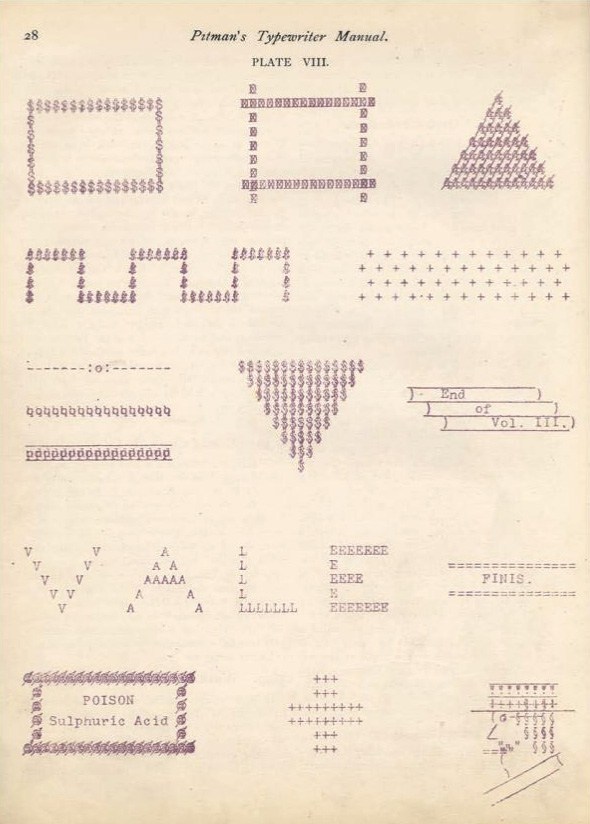
Pitman’s Typewriter Manual (1893)
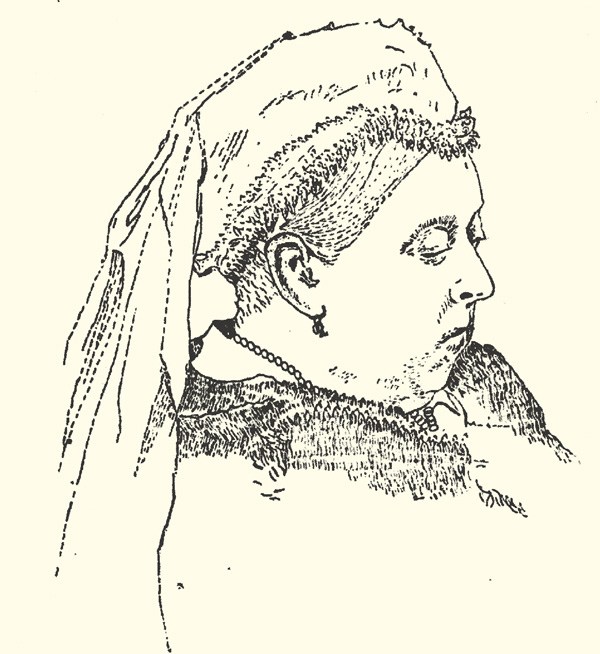
Queen Victoria by an unknown artist (c. 1900), published in ‘The History of the Typewriter’ by George Mares (1909)
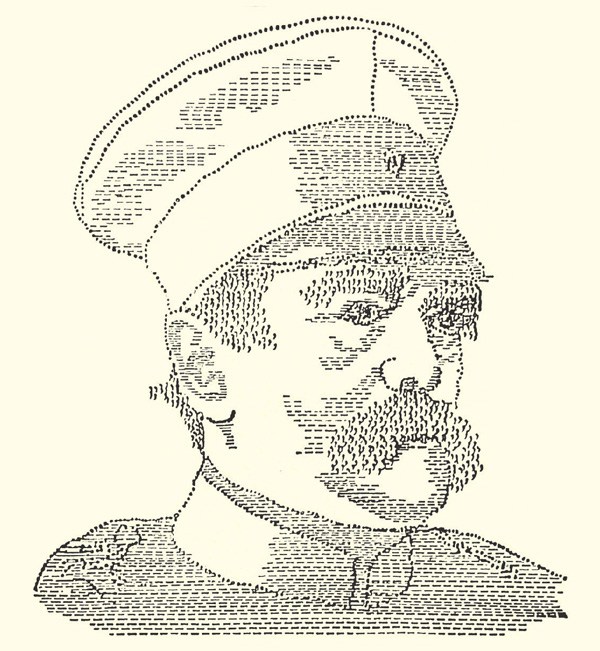
Otto von Bismarck, unknown artist (1898), published in ‘The History of the Typewriter’ by George Mares (1909)
But first, back to the basics: Lest we forget, the typewriter, like all technology, went from revolutionary in its heyday to sentimental monument of obsolescence in our era. For those born after its mainstream decline, Tullett offers a basic primer on how a typewriter actually works, complete with the proper terminology:
The typewriter is designed to be used in a very simple way. A piece of paper is inserted into the back of the platen (the roller). This then feeds around to the front so that the paper sits behind a colored ribbon, usually black, or black and red. As a letter on the keytop is pressed, a typebar is raised. This then strikes the ribbon to make the impression of a character on the paper behind it. The carriage return moves forward one space, then the typebar for the next character can be pressed. When the end of the line is reached, the carriage is returned (manually), the platen rotates to position the paper ready for the next line to begin and the process is repeated until the page is full.
Tullett notes the unconventional path taken by the early practitioners of typewriter art:
The surviving pieces from this period of typewriter art’s history were created by people with a background in secretarial studies rather than art. Although we have no historical detail about their lives, their artistic education would presumably have been limited to what they had been taught at school, and the representational vernacular.
Though early typewriter art made its mark, the golden age of the discipline was still decades away — it wasn’t until the concrete poetry movement of the 1950s–1970s, best described as concerned with “poetry that appeals to the eye and not the ear,” that the typewriter became a commonly embraced artistic medium.
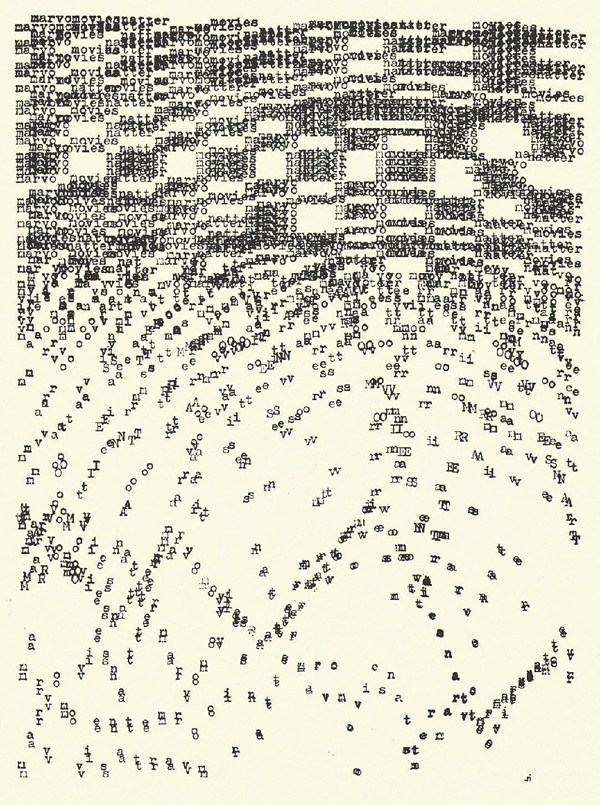
‘Whisper Piece’ by Bob Cobbing (1969)
Originally a painter, Cobbing was famous for his sound, visual, concrete and performance poetry, as well as his role as a publisher for his Writers Forum press. In 1968 he founded the Westminster Group of experimental poets (WOUP). He created a link between the silent poetry of text on the page and the audioscapes of sound poetry. Cobbing’s work became more and more experimental as his career developed; almost any mark that could be made and any sound that could be heard were viable ingredients for his prolific creative output.
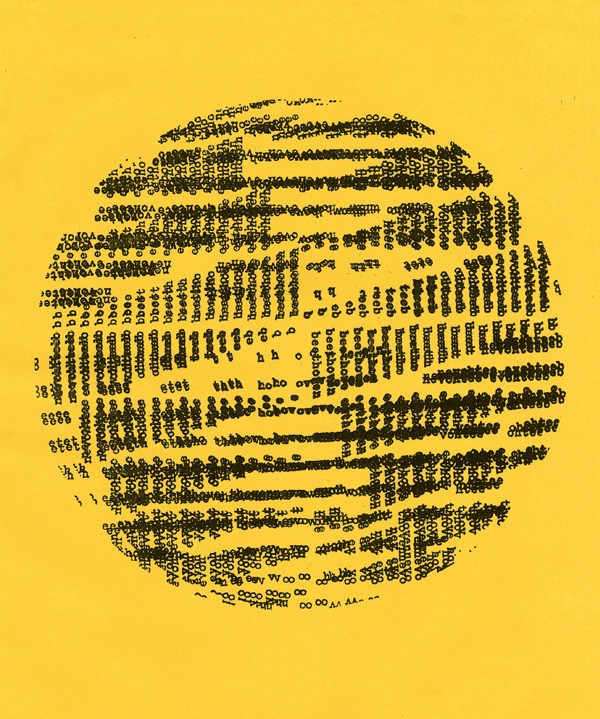
‘Beethoven Today’ by Bob Cobbing (1970)
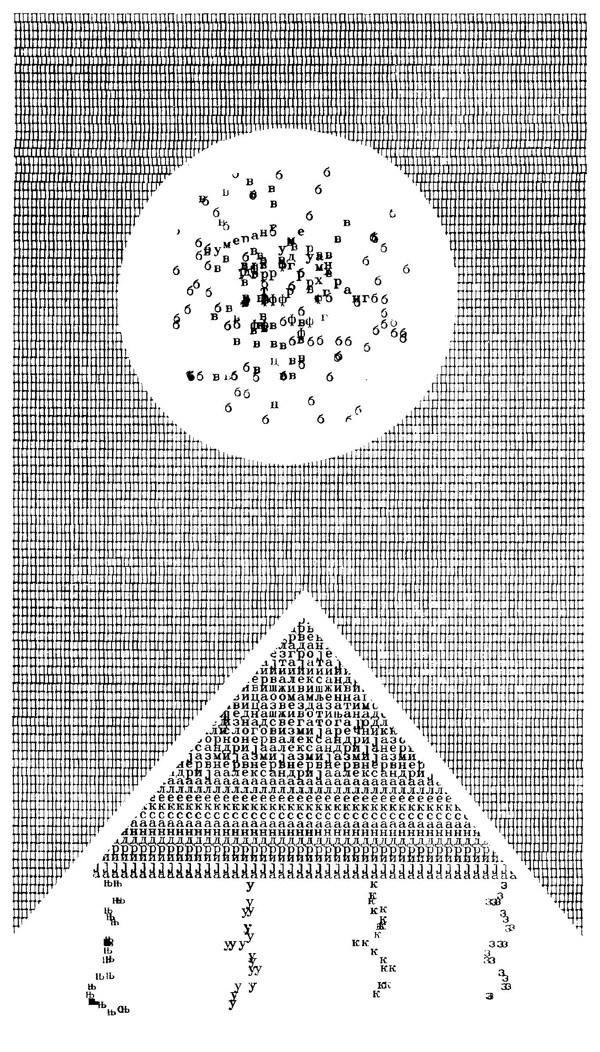
‘Textum 2’ by Miroljub Todorovic (1973)
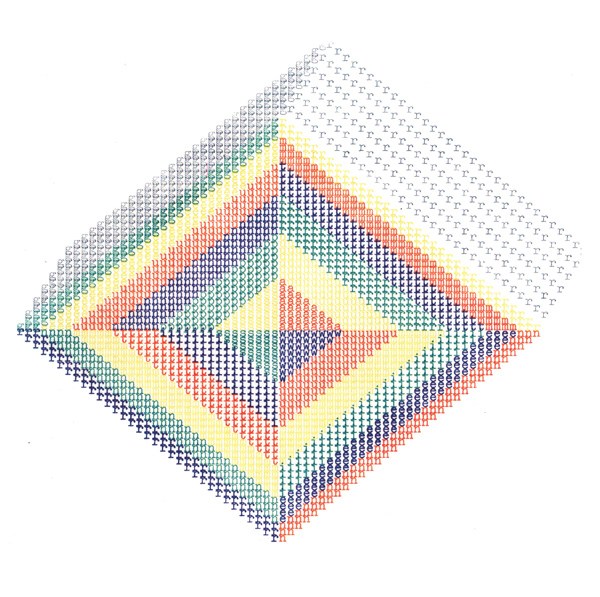
Politically active as a law student in Serbia, Todorovic participated in the student uprisings of May 1968; he founded the avant-garde artistic and literary movement Signalism a year later. During his career he worked as a journalist, teacher and magazine editor, and also worked for the Ministry of Culture. He retired in the early 1980s to devote himself to his literary and artistic work, including collages, drawings, visual poetry, mail art and conceptual art. His work has featured in a number of national and international exhibitions.
‘O’ from The Season Suite, a serial visual poem by Alan Riddell (1975–1976)
Although born in Australia, Riddell was bought up in Scotland and went on to live in Greece, Spain, France and Australia. Originally a traditional poet, he was introduced to concrete poetry by Ian Hamilton Finlay in 1963. A major figure in the promotion of typewriter art, Riddell organized two major shows of work in Edinburgh and London, as well as editing the book Typewriter Art (London Magazine Editions, 1975). For almost fifty years it was the only major publication on the subject. His opus, The Seasons Suite, remained uncompleted at the time of his death.
To be sure, the link between typewritten text and narrative form had been around since the dawn of the technology — it all began in the late 1800s when Mark Twain, a pioneer in more ways than one, delivered his first typed manuscript to his publisher, sparking the intimate relationship between literary thought and typed text.
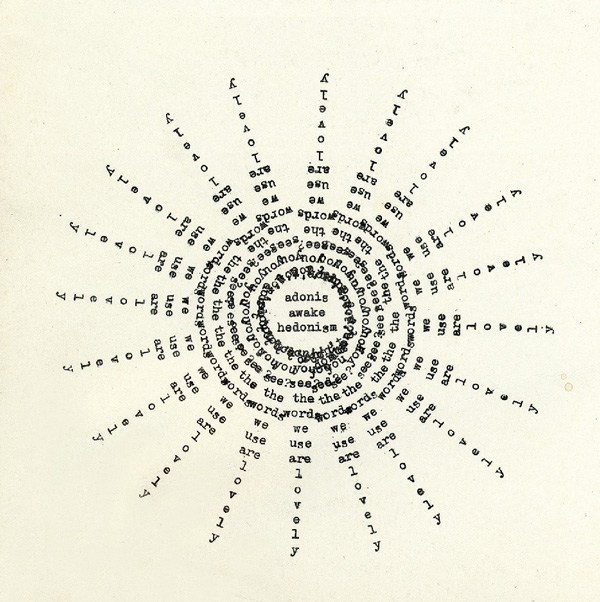
‘the words we use are lovely’ by J.P. Ward (1973)
Both a traditional and concrete poet, Ward firmly believed that the old-fashioned typewriter poem (c. 1960–80) should exploit that machine’s nature, rather than what is handwritten or printed. His work thus evinced a fascination with geometry, abstraction and the search for a deeper truth that goes beyond surface detail, looking instead for ‘more elaborate patterns, including semantic ones, requiring only the poets with the patience to find them.’ In the 1990s came the digital word-processor, taking him to different approaches.
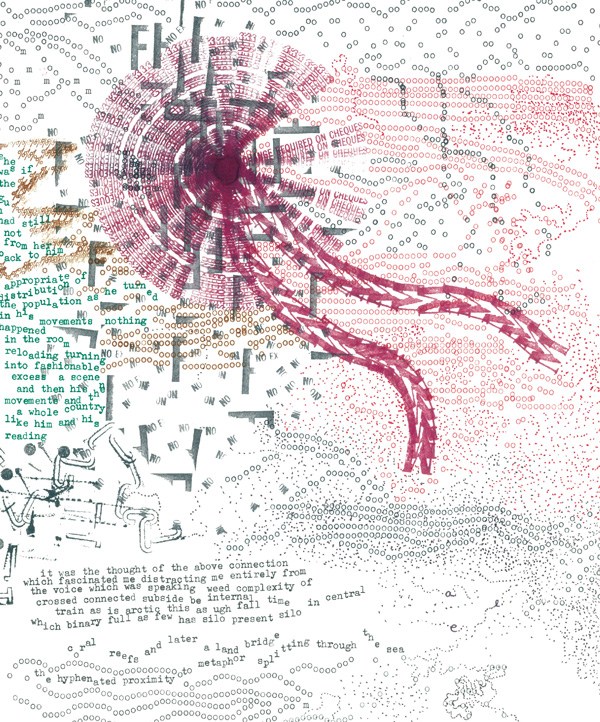
Panel from ‘Carnival’ by Steve McCaffery (1970–1975)
McCaffery’s experiments with the disintegration/reintegration of language began in the mid-1960s. In the 1970s he formed the sound poetry group the Four Horsemen with three other poets. The two panels of Carnival, produced between 1967 and 1975, are among the most significant pieces of typewriter art/concrete poetry/sound poetry ever produced. McCaffery saw it as ‘essentially a cartographic project; a repudiation of linearity in writing and the search for an alternative syntax in “mapping”.’ The work developed and grew throughout the two panels to gain typographic complexity, moving from the simplicity of the red and black masks of a typewriter ribbon to include colored rubberstamped letterforms, carbon-paper frottage, wet-feed electrostatic disintegrations and holograph. A third digital panel was conceived in 2012, comprising a superimposition of the earlier two panels and has been published (in reduced size) as a poster.
Shortly after the golden age of concrete poetry, the punk movement saw in the typewriter a creative intersection of the practical and the political — a medium that enabled the cheap production of texts that could be printed and photocopied for wide dissemination.
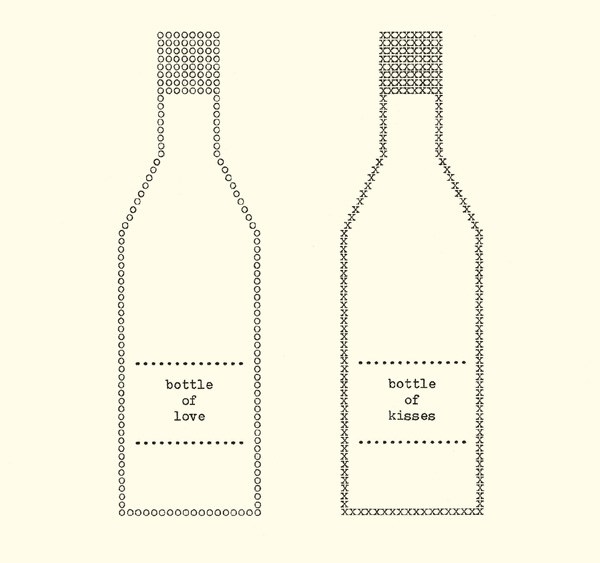
‘Unusual Love Poem’ by Andrew Belsey (1987)
Today, as the typewriter’s sun sets over the horizon of practical utility, what remains is its aura of nostalgic obsolescence — something that imbues contemporary typewriter art with a whole new cultural sensibility that weaves the medium’s nostalgia into the conceptual message.
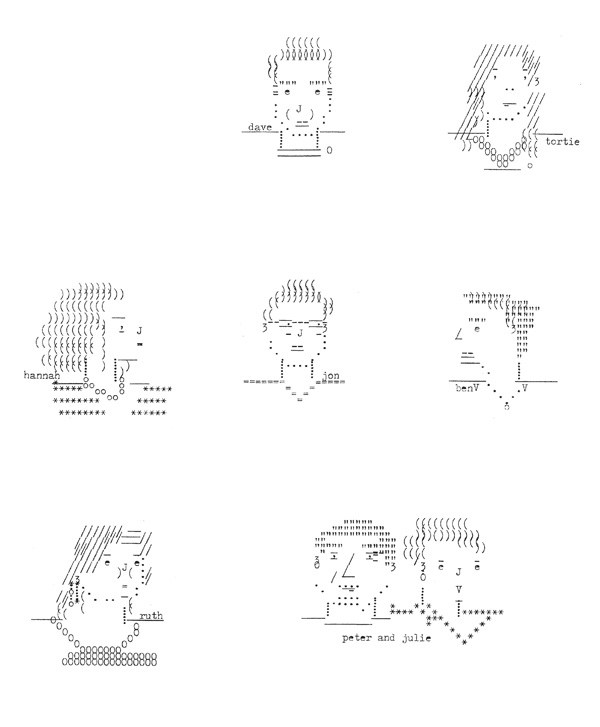
Selection from ‘Typewritten Portraits’ by Nadine Faye James (2007)
A British illustrator, James produces work in a variety of mediums, including pen and ink, photocopies, Omnicrom, letterpress, Letraset, typewriters and the occasional screenprint. Her witty and economical type portraits connect her with the earliest typewriter artists and the work they produced over a hundred years ago.
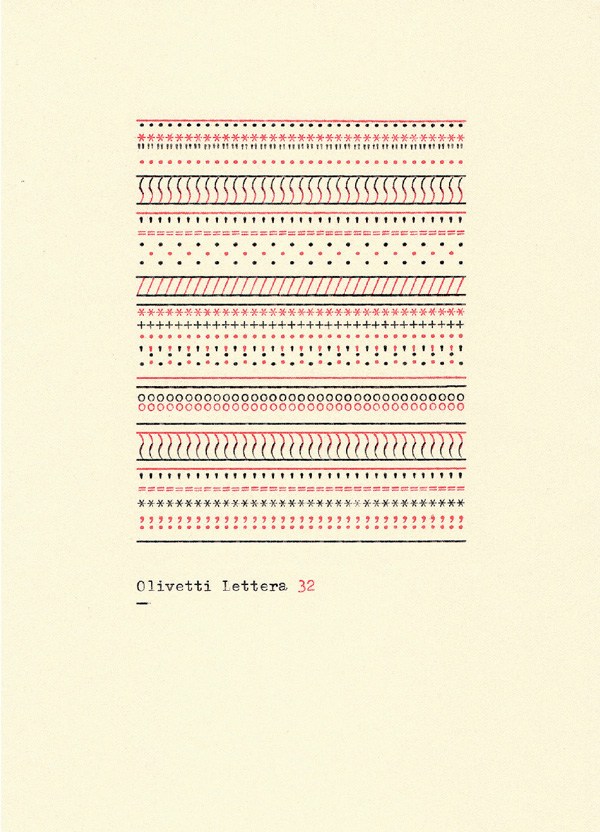
‘The Pattern Series’ by Vickie Simpson (2012)
Simpson investigates the aesthetics of the handmade. For her, inspiration cannot be found on a screen but only in the physical exploration and making of tactile forms. The Pattern Series asks the viewer to consider the physicality of manual mark-making in our increasingly digitized world.
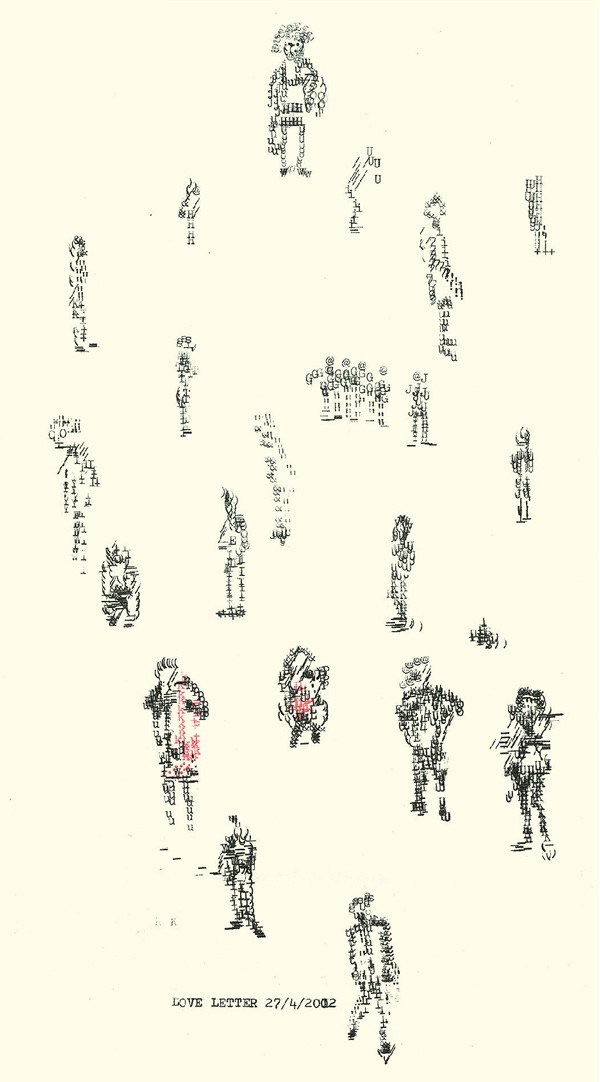
‘Barcelona Love Letters’ by Keira Rathbone (2012)
Typewriter Art goes on to illustrate the history of the genre through ample artwork spanning nearly 130 years as well as a handful of interviews with some of the most prominent artists in the field today. It comes from British publisher Laurence King — the indie powerhouse behind the magnificent Saul Bass monograph, the graphic biography of Dalí, and the series 100 Ideas That Changed Graphic Design, 100 Ideas That Changed Film, 100 Ideas That Changed Architecture, 100 Ideas That Changed Photography, and 100 Ideas That Changed Art.
